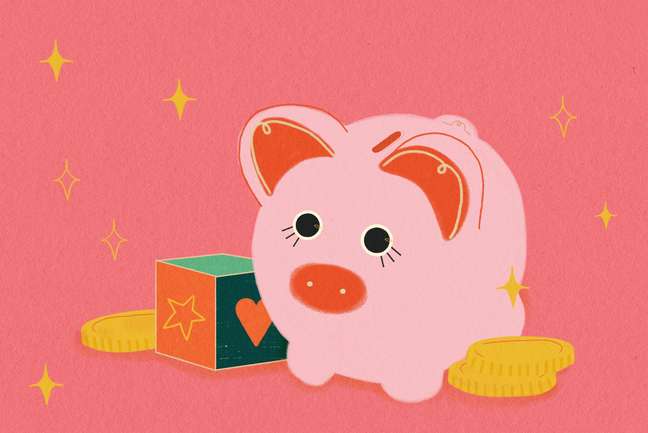Financial experts explain how parents should introduce the topic to their little ones and since when to offer payments to their children
When is the right time to talk about money with your children? Well, for the human and financial development specialist, Tamirys Machado, from the age of three it is already possible to start a dialogue on financial education with children. In fact, the sooner this problem is addressed indoors, the better! This will make it easier for the little ones to develop a solid and healthy relationship with finances.

“Many of our precepts are acquired in childhood. If parents don’t take care of them promote positive experiences in relation to money with children, this will happen completely unconsciously over time, ”adds Rebeca Toyama, an expert on behavior, financial well-being and careers.
Always respecting the age group, the subject can be inserted in a playful way in everyday life, together with the temporal problems of the child’s routine. “From the moment we teach children the correct way to manage, see and manage money, this will carry you back to adulthood“, Tamirys completes.
How to approach money at any age?
Children are born questioning and have a very fertile imagination. Therefore, a good first step in introducing the topic with them is tell stories and develop games involving finance.
” Explain what money is, how it came about, why it is important and the difference between banknotes and coins“, guides Tamirys. Even underage children will already be able to understand that this exchange mechanism exists and is relevant to the family. Find out more tips from the experts:
From 3 to 5 years old
In this age group, children They learn most things through observation and imitation. For this, taking advantage of everyday situations, some stories and even games is the best way to introduce children’s financial education at home.
” Bet on games that include cash in rounds, like grocery stores, for example. This helps the child understand that there is an exchange: I give you the product and you give me the money. He understands that, in the real world, this will also exist “, says the expert.
From 6 to 9 years old
In this age group, children can already progress to small stones. bet on teach the difference between products and services, the importance of work, pay for the family and, above all, the need to save and save money.
“After age 7, we can introduce the concept of savings. We show the child that, by saving some of what he receives, he can accumulate coins to buy something more valuable,” says Rebeca.
From 10 to 14 years old
This age group allows us to explain the importance of investments, bank accounts, how digital money and financial control at home works, as well as the bills that need to be paid each month and the difference in product values more effectively. , says Tamirys.
Still at this stage, Introducing topics related to career, business and entrepreneurship can also bring good results for the professional and financial life of childrencompletes Rebecca.

Is a check important?
The idea of offering a periodic payment to the child is of great value. Like this, the child will begin to understand and validate how remuneration works, also introducing a planning awareness have small achievements in life.
“The concept of allowance, of adding value to buy what you want with your money, makes you begin to understand the importance of savings to achieve goalsor acquire that toy that would naturally come from parents, ”Tamirys believes.
The indemnity proposal, therefore, is teach the child to have autonomy of choice, at the same time that he has to deal with the limitation of the purchasing power of the money received. “Children who know how to control their impulses become healthier adults, not just financially,” Rebeca completes.
However, the allowance must be well thought out to be effective. The little one needs to understand that he is paid because he is an important part of the family and helps with household activities. Everything must be very well balanced!
How to correctly enter the allowance
The first step is always explain why the child receives the benefit. “It is important for parents to talk to their children and clarify why they are receiving this amount. For example, phrases like ‘since you help parents at home, you can start getting a check’ is worth betting. This process becomes easier when you have already explained to the child what money is and its importance.“Tamirys instructs.
The resource can be used from 4 years of age. But with this also comes the time to decide, together with the child, what he wants to achieve with this allowance and how much he has to save for it.
With younger children, the result has to be something faster to achieve, so focus on the small milestones. Older children, on the other hand, can focus on bigger goals. “The interesting thing is to follow the mathematical reasoning also offered at school, so that the child can apply the mathematical operations together with the financial exercise, favoring a multidisciplinary learning”, adds Rebeca.

Arrange the amount of payments
Each family has its own financial reality. Therefore, the organization of the values that will be given to children must be in line with the model and lifestyle of the parents, Rebecca remembers. There is no ideal amount for every age, the factor that needs to be taken into consideration is primarily the waiting time.
“Between the ages of 3 and 9, children are very immediate. Hence, a monthly subsidy could cause an inverse, frustrating effect. Separating by weeks, the value varies according to the financial education of the parents and the purchasing power of the family. family. be R $ 5 to R $ 2, for example, “explains Tamirys.
Be careful not to make these mistakes!
Be very careful not to make the child think that he needs to do something to get the remuneration in return. Ideally, he understands it’s not just that. ” The allowance is also given for the sake of the parents, because the child belongs to that family“says Tamiries.
Attitudes such as paying for household or school activities, which are already your responsibility, are generally not positive in the long run in educating the child as an adult, Rebeca adds. It is therefore necessary that some activities are carried out regardless of whether or not you have an allowanceso that the child does not create a mechanism that he does just because he receives something in return.
Another cure, Tamirys points out, is not to provoke the frustration effect. “If the child takes a long time to get something, the check will not be positive and the child will understand that saving is bad,” she explains. For this reason, arranging payments by age is key.
Keep in mind that the idea of benefit is establish a balance between immediate and future pleasure, ensuring that the child’s relationship with money is lightRebecca concludes.
+The best content in your email for free. Choose your favorite Earth Newsletter. Click here!
Source: Terra
Benjamin Smith is a fashion journalist and author at Gossipify, known for his coverage of the latest fashion trends and industry insights. He writes about clothing, shoes, accessories, and runway shows, providing in-depth analysis and unique perspectives. He’s respected for his ability to spot emerging designers and trends, and for providing practical fashion advice to readers.







